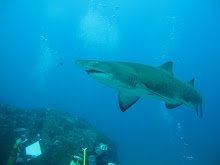

The east coast population of Grey Nurse Sharks is listed as Critically Endangered. The Great Lakes Underwater Group (GLUG) are familiar with the “Spot a Shark” program, a non-profit dive community research project that uses photo-identification techniques to monitor grey nurse shark populations on the east coast of Australia.
Club members often send down photos of grey nurse sharks for possible matches. One diver in particular has had a few of her shark photos from Seal Rocks identified as the same sharks sighted at Magic Point or Fish Rock.
Peter Simpson and Sean Barker from “Spot a Shark” were invited up to give a presentation of their work to the members of GLUG and the general public as part of the Great Lakes Marine Discovery Series. The following morning GLUG planned to take them out to Seal Rocks to continue the task and complete some field training for GLUG members. The presentation at Club Forster was well received and both guys were happy to answer any questions about their program. The project is based on non-invasive photographic identification system then identifies and tracks individual grey nurse sharks between key aggregation sites in NSW.
Each shark has a series of pigmentation spots on either side of their body. These markings are unique to each shark. One device they use is two laser pointers attached to their cameras to ascertain the length of the shark. A left facing shark photograph is preferable as each side of a shark is different to the other side. It turns out Seal Rocks is an integral part of the shark migration being half way between Magic Point and Fish Rock.
Divers met at Forster marina early the next day to load up the boat then drove down to Seal Rocks for a short snorkel out to the boat to drop anchor off nearby Big Seal Rock. The water had good visibility and still reasonably comfortable at 19 degrees. Approximately thirty grey nurse sharks were sighted; unfortunately at least three animals had hooks in their mouths or gills. The songs of the whale could be heard throughout the entire dive.
Aside from the sharks also sighted was a large loggerhead turtle, girdled parmas, mado, maori wrasse, comb wrasse, one spot pullers, bulleyes, red morwong, blue and brown grouper, red rock cod, goatfish and a large wobbegong, all duly recorded on slates and photographed for our identification and research work. Total dive time was 40 minutes with a maximum depth of 24.8 metres.
A second dive was done at the same site, as Peter and Sean were more than happy with both the conditions and number of grey nurses. Total dive time was 41 minutes with a maximum depth of 23.3 metres.
HEATHER ARMOUR




No comments:
Post a Comment